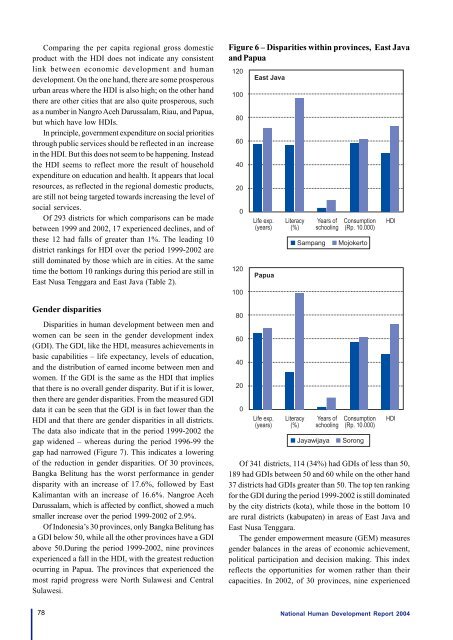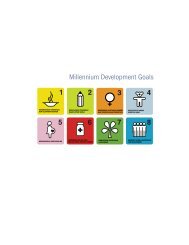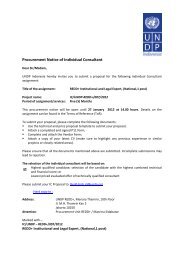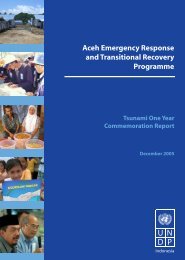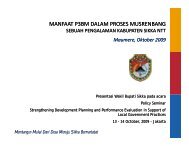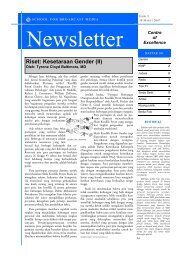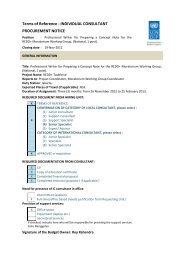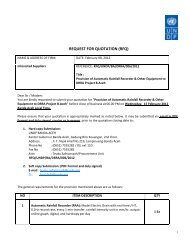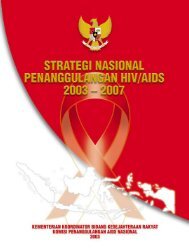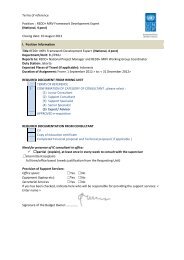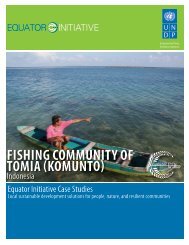Download the Indonesia Human Development Report 2004. - UNDP
Download the Indonesia Human Development Report 2004. - UNDP
Download the Indonesia Human Development Report 2004. - UNDP
Create successful ePaper yourself
Turn your PDF publications into a flip-book with our unique Google optimized e-Paper software.
Comparing <strong>the</strong> per capita regional gross domesticproduct with <strong>the</strong> HDI does not indicate any consistentlink between economic development and humandevelopment. On <strong>the</strong> one hand, <strong>the</strong>re are some prosperousurban areas where <strong>the</strong> HDI is also high; on <strong>the</strong> o<strong>the</strong>r hand<strong>the</strong>re are o<strong>the</strong>r cities that are also quite prosperous, suchas a number in Nangro Aceh Darussalam, Riau, and Papua,but which have low HDIs.In principle, government expenditure on social prioritiesthrough public services should be reflected in an increasein <strong>the</strong> HDI. But this does not seem to be happening. Instead<strong>the</strong> HDI seems to reflect more <strong>the</strong> result of householdexpenditure on education and health. It appears that localresources, as reflected in <strong>the</strong> regional domestic products,are still not being targeted towards increasing <strong>the</strong> level ofsocial services.Of 293 districts for which comparisons can be madebetween 1999 and 2002, 17 experienced declines, and of<strong>the</strong>se 12 had falls of greater than 1%. The leading 10district rankings for HDI over <strong>the</strong> period 1999-2002 arestill dominated by those which are in cities. At <strong>the</strong> sametime <strong>the</strong> bottom 10 rankings during this period are still inEast Nusa Tenggara and East Java (Table 2).Figure 6 – Disparities within provinces, East Javaand PapuaGender disparitiesDisparities in human development between men andwomen can be seen in <strong>the</strong> gender development index(GDI). The GDI, like <strong>the</strong> HDI, measures achievements inbasic capabilities – life expectancy, levels of education,and <strong>the</strong> distribution of earned income between men andwomen. If <strong>the</strong> GDI is <strong>the</strong> same as <strong>the</strong> HDI that impliesthat <strong>the</strong>re is no overall gender disparity. But if it is lower,<strong>the</strong>n <strong>the</strong>re are gender disparities. From <strong>the</strong> measured GDIdata it can be seen that <strong>the</strong> GDI is in fact lower than <strong>the</strong>HDI and that <strong>the</strong>re are gender disparities in all districts.The data also indicate that in <strong>the</strong> period 1999-2002 <strong>the</strong>gap widened – whereas during <strong>the</strong> period 1996-99 <strong>the</strong>gap had narrowed (Figure 7). This indicates a loweringof <strong>the</strong> reduction in gender disparities. Of 30 provinces,Bangka Belitung has <strong>the</strong> worst performance in genderdisparity with an increase of 17.6%, followed by EastKalimantan with an increase of 16.6%. Nangroe AcehDarussalam, which is affected by conflict, showed a muchsmaller increase over <strong>the</strong> period 1999-2002 of 2.9%.Of <strong>Indonesia</strong>’s 30 provinces, only Bangka Belitung hasa GDI below 50, while all <strong>the</strong> o<strong>the</strong>r provinces have a GDIabove 50.During <strong>the</strong> period 1999-2002, nine provincesexperienced a fall in <strong>the</strong> HDI, with <strong>the</strong> greatest reductionocurring in Papua. The provinces that experienced <strong>the</strong>most rapid progress were North Sulawesi and CentralSulawesi.Of 341 districts, 114 (34%) had GDIs of less than 50,189 had GDIs between 50 and 60 while on <strong>the</strong> o<strong>the</strong>r hand37 districts had GDIs greater than 50. The top ten rankingfor <strong>the</strong> GDI during <strong>the</strong> period 1999-2002 is still dominatedby <strong>the</strong> city districts (kota), while those in <strong>the</strong> bottom 10are rural districts (kabupaten) in areas of East Java andEast Nusa Tenggara.The gender empowerment measure (GEM) measuresgender balances in <strong>the</strong> areas of economic achievement,political participation and decision making. This indexreflects <strong>the</strong> opportunities for women ra<strong>the</strong>r than <strong>the</strong>ircapacities. In 2002, of 30 provinces, nine experienced78National <strong>Human</strong> <strong>Development</strong> <strong>Report</strong> 2004


